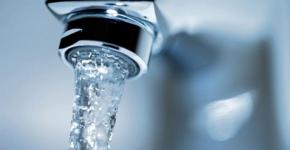Ways to test water quality at home. Drinking water: how to check the quality
How to check the quality of water
An adult should drink about 1.5-2 liters of water per day. The purity of the consumed fluid, given that our body is on average 75% composed of H 2 O, and the environment leaves much to be desired, is very important. The actual question is: how to check the quality of water not only in the laboratory, but also at home.
Checking water quality at home
Qualities that should be inherent in the most necessary for all living things on Earth fluid:
- transparency;
- colorlessness;
- lack of smell;
- tastelessness;
- radiological neutrality;
- lack of chemical and biological impurities.
Few people in the apartments have a device for carrying out complex special studies, as in a laboratory, but almost all of the listed characteristics can be obtained without it.
Transparency and colorlessness
According to the norms of SES (SanPiN 2.1.4.1074-01), the color of drinking water should be at least 20 о on a platinum-cobalt scale. At home, the indicator is determined visually. To do this, simply pour the liquid into a transparent glass and look through it onto a white sheet of paper attached to the back of the container.
If the sheet appears dark, it can be assumed that organic matter is present in the material under study. The presence of iron gives a light brown color. Such shades do not signal the danger of poisoning if the water is raised from a deep well or an artesian well, but completely unacceptable for drinking water from surface sources.
Only transparent water is suitable for drinking. It is determined in the same way as chromaticity using a clean glass cup and a white sheet of paper. In Moscow, in the laboratory, a colorimeter is used for this, which shows and measures color in quantitative, not qualitative, terms.
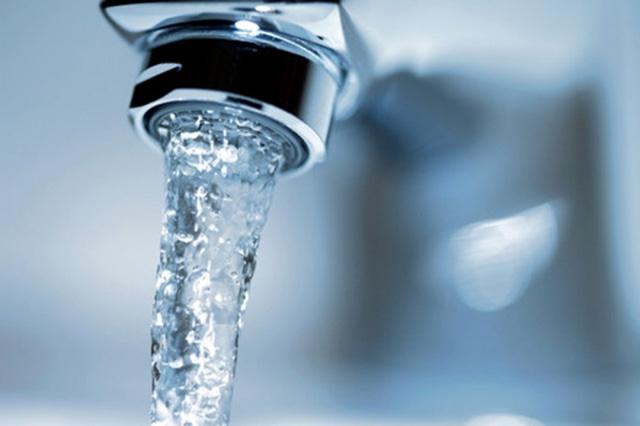
For such tests, nothing has been thought out yet better than the human sense organs. Evaluate the testimony of a five-point system, which is also set subjectively. You can eat only water, rated at 0, 1 or 2 points.
A home-based water quality test for odor begins with bringing its temperature to 20 o C. It is sniffed and heated again to 60 o C. Sometimes a putrid odor emanates from warm water from a well or well. This is an indicator of the increased content of hydrogen sulfide in it. In small quantities, it is even useful. Many have heard or experienced the therapeutic effects of hydrogen sulfide baths.
It is necessary to boil the liquid for 5 minutes and, after cooling down again to 25 ° C, taste it:
- sweet water, if it contains particles of gypsum;
- bitterness is given in magnesium salts;
- iron salts make it tart;
- taste rot indicate the presence of organic compounds.
In Moscow and other cities in some boilers, even at nuclear power plants they breed fish in aquariums. These are the most accurate indicators of the quality of their habitat. Without such a natural "device", you can simply put a drop on the smooth, clean surface of the glass or mirror and wait until it dries. The brightness of the remaining spot indicates the degree of purity.

The amount of magnesium and calcium salts determines the hardness of the water, which does not affect the usefulness and harmfulness of the liquid. Magnesium can give it a slightly bitter taste. Water with increased hardness:
- when boiling leaves on the walls of dishes a large amount of scale;
- it boils vegetables for a long time;
- washing soap or soap is bad.
Tap water
It is no secret that some scammers sell drinking water, which they collect not from a well or a mineral spring, but directly from a water tap. Profitability, profitability of such a business is 200%. Fraudsters go about the apartments and offer to buy the water that everyone can pour free of charge from the tap.
But is it possible to drink this water? Its constant thorough check is carried out by the SRP PLC (the main test center for drinking water). In this independent accredited laboratory in Moscow and other Russian cities, analyzes are carried out on the content of phenols, pesticides, anions, metal ions, surfactants and other toxic substances in the liquid.
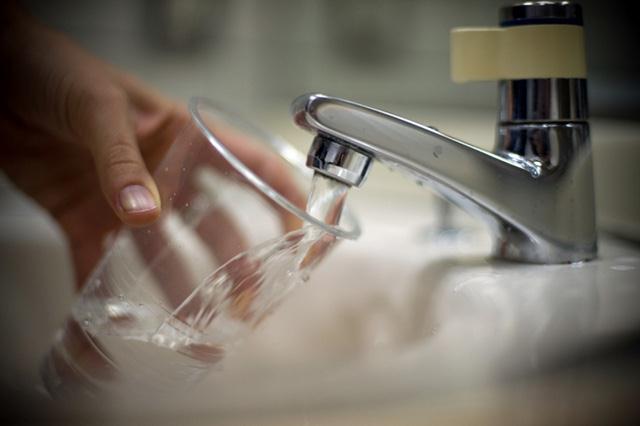
For independent research, samples are taken from any sources (wells, wells, bottled water, plumbing, springs, etc.), both from organizations and from individuals. Based on the results of the inspection, a written analysis report and recommendations on the cleaning and use of certain filters are issued.
It is necessary to use caution with hot tap water, where it is not a hot water boiler, but a direct one that is used. Since in many cities, state quality control applies only to the cold water system.
The water used in the gardens as drinking water is taken from a depth of 5 to 30 meters. These are those aquifers where external pollutants seep without problems. It is clear that we can’t influence the activities of the plant in the neighborhood or agricultural land, but we can observe ourselves. By pouring out water after washing or washing dishes on a garden bed, the hostess “enriches” the aquifer of the soil with a whole bunch of chemical pollutants. The same applies to washing machines, the use of fertilizers and plant protection products, the installation of uninsulated cesspools.
Someone will say that if the water is clear and odorless, then it is potable. This is not true. According to state standards (GOST and SanPin), the quality of water is determined by the content of chemical, biological components and organoleptic properties in it. Only a small part of them are “noticeable by eye” - by color or smell and taste. If, for example, excess calcium salts can still be detected by scale in a kettle, and a high iron content will produce a specific taste, then the presence of surfactants (surfactants) in water is very difficult to determine.
How to find out what we drink? The answer is simple - check the composition of the water. The best solution would be to conduct a water analysis in accordance with the state quality standard. Laboratory research will allow to determine the quantitative content of substances according to the main indicators, its suitability for drinking and domestic needs, as well as to determine whether it is enough just to boil water or to install a filter for cleaning. Natural sources are not under the constant control of sanitary services, because care about the quality of water falls on the shoulders of summer people themselves.
Water analysis can be carried out at a sanitary-epidemiological station, in specialized independent laboratories, scientific institutions or as a bonus when contacting an organization for the installation of water treatment plants. Whatever you choose, the laboratory must be accredited, and the methods used must comply with the State Standard of the Russian Federation.
The cost of research depends on the choice of organization and type of analysis. Laboratories carry out analyzes of three types:
- basic (abbreviated);
- full;
- specific (the definition of individual
- indicators depending on the needs of the customer).
A complete analysis is recommended for the primary examination of the water source. In the future, conduct basic annual preventive quality control. The choice of research depends on the specifics of the water. It includes from 7 to 16 indicators, the cost of analysis is about 2500 rubles. A complete analysis consists of four dozen indicators - it costs about 4,000 rubles. Any organization offers the client to take the sample himself in accordance with the selection rules that can be learned in the laboratory and bring it to the analysis. If the summer resident has no such possibility, a specialist leaves for the place, which increases the cost by 1000-2000 rubles. Results can be obtained within one to two days. 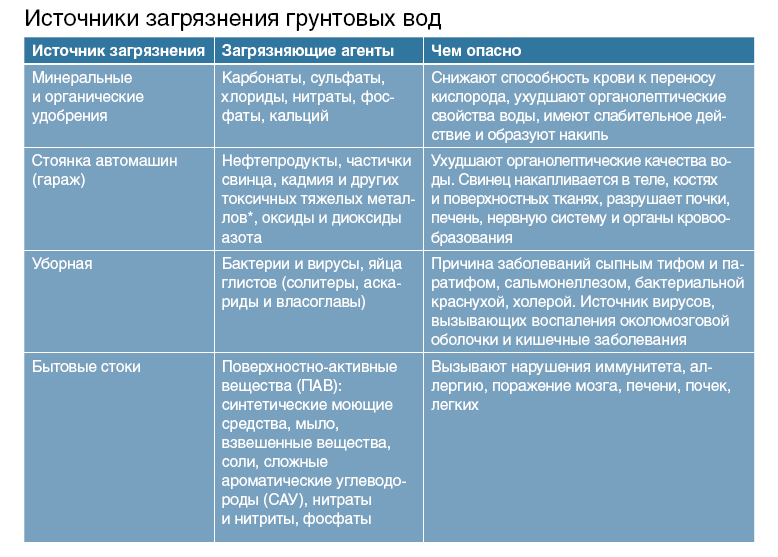
In conclusion, the laboratory issues a protocol containing the information on the quantitative content of the test substances, a conclusion on the suitability of water for household use in accordance with GOST 2874-84 and SanPin 2.1.4.1074-01, including recommendations for the treatment and treatment of water. The benefits of such research is great: health is priceless. The cost of research can be reduced with centralized water supply. The amount is divided between neighbors and becomes minimal. 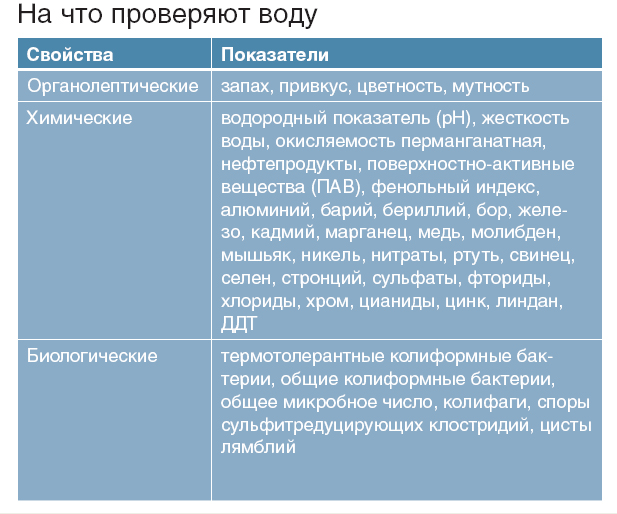
According to the UN, about 25% of Ukrainians do not drink enough clean water. How to determine the quality of water consumed? There are some simple ways.
The simplest experiment to determine the quality of water - the assessment of appearance and taste. Water should be clear, without sediment, without chemical or any other smell. Color, transparency, acidity / alkalinity, hardness, the content of solutes and suspended particles can also be determined at home.
To determine the degree of transparency, water is poured into a transparent glass with a layer of 20 cm. Try to read the text on paper, looking through a glass of water. If this is easy to do, the water is clear. Impurities - finely dispersed suspensions of organic or inorganic origin - create turbidity of water, which causes the growth of bacteria and does not allow ultraviolet to destroy microorganisms.
The color of water is determined in a similar way: pour 100 ml of water into a transparent glass and examine it against the background of white paper. Organic matter that decomposes in water gives the water a dark color.
At home, soaping can determine the hardness of the water: if the soap foams badly in the water, the water is harsh. The same can be said about the water that forms sediment during boiling.
The smell of water can also tell a lot about its purity. First, heat the water to 20 ° C, then to 60 °. The putrid odor of water indicates the presence of hydrogen sulfide in its composition. To taste the water in a clean container, boil a small volume of water for 5 minutes, then cool to 20 ° -25 ° C. If the water has a sweetish taste, it contains gypsum, bitter - magnesium salts, astringent - iron salts. The rotten taste is given to the water by the decay products of plant or animal organisms.
Filtration can determine the presence of foreign particles in the water. To do this, the water must be defended for some time, and then filtered.
It is believed that the weight of water also indicates its quality - lighter water is considered good.
Add a weak solution of potassium permanganate to the water. If the liquid quickly turns yellow - the water is of poor quality.
Also, the quality of water can be judged by holding it up. To do this, pour water into a small transparent container (for example, a 3-liter jar) and leave it for 2-3 days in a dark place. After this time, inspect the liquid: about its poor quality of water may indicate its greenish tint, the film on the surface, the plaque or stains on the walls of the tank. And vice versa: if the water is clear, there is no sediment on the walls - it is of good quality.
![]() Apply a small drop of water to the glass or mirror. Wait for the liquid to evaporate. Then look at the surface: if it remains clean, the water is also clean. If any stains have appeared on the glass, this is a sign of poor water quality.
Apply a small drop of water to the glass or mirror. Wait for the liquid to evaporate. Then look at the surface: if it remains clean, the water is also clean. If any stains have appeared on the glass, this is a sign of poor water quality.
If you have an aquarium, follow its inhabitants: many of them are very sensitive to water quality. For example, freshwater mollusks of the family Unionidae close the shell valves, if there are impurities in the water, even in small quantities - this is stated in an article in the newspaper Ecoportal.su.
However, all these methods have their drawbacks. The most complete information can be obtained by ordering a full water analysis from specialists. And if the water is not suitable for use, you can think about installing equipment for water purification from leading Ukrainian manufacturers -


